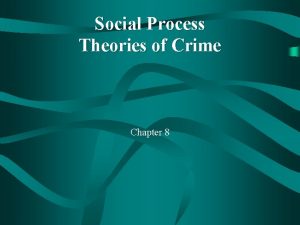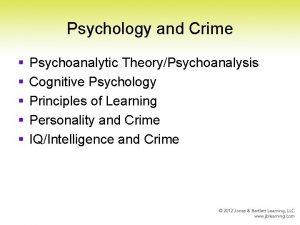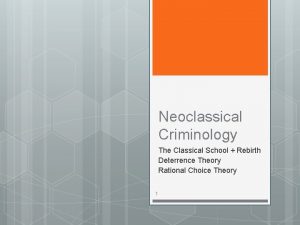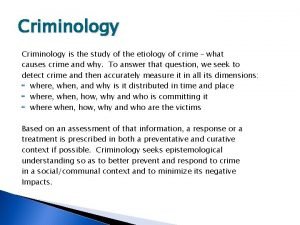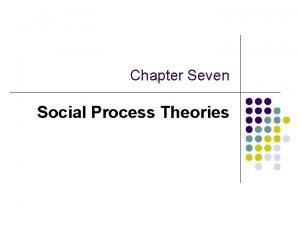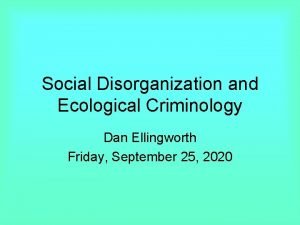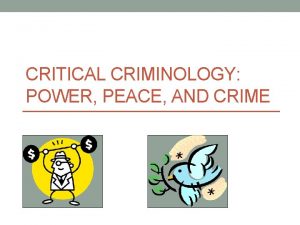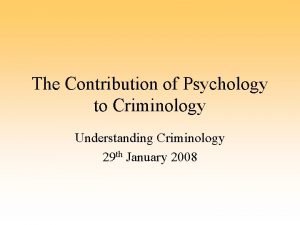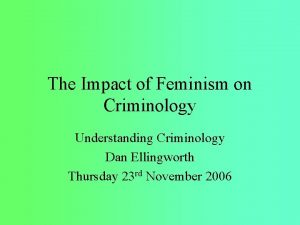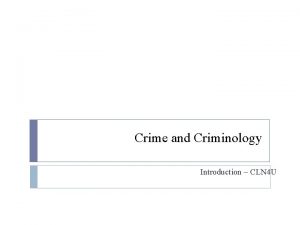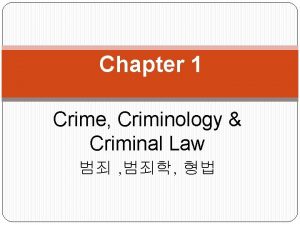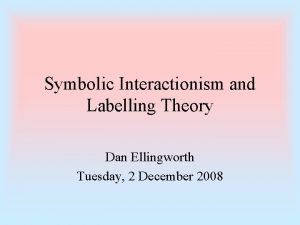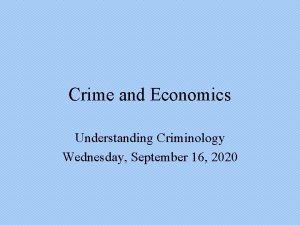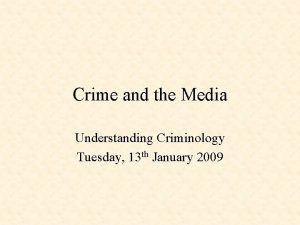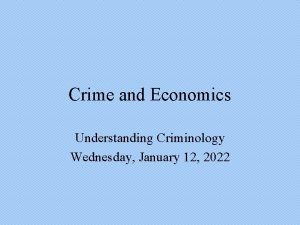Youth and Crime Understanding Criminology Dan Ellingworth 29























- Slides: 23

Youth and Crime Understanding Criminology Dan Ellingworth 29 November 2020

Lecture Outline • • Youth Culture Patterns of Youth Offending Formal Responses to Juvenile Crime Deconstructing the Youth / Crime link

We will never get reasonable behaviour among the young until we bring back National Service. Without decent standards to guide them, the young have become lawless. Before the war there was little lawlessness. We need to return to those days Over the past 20 years or so, there has been a revulsion from authority and discipline The adolescent has learned no definite moral standards from his parents, is contemptuous of the law, easily bored The passing of parental authority, defiance of pre-war conventions, the absence of restraint, the wildness of extremes, the wholesale drift away from the churches are but a few characteristics of after-war conditions Our young people have no idea of discipline or subordination The manners of children are deteriorating… the child of today is coarser, more vulgar, less refined than his parents were They (young people) are the links that have fallen off the chain of society which are going to decay and obstruct the whole machine I believe that youth should sleep out the years between the age of 10 and 23; there is nothing in between but getting women pregnant, wronging the elderly, stealing, fighting

We will never get reasonable behaviour among the young until we bring back National Service. Without decent standards to guide them, the young have become lawless. Before the war there was little lawlessness. We need to return to those days 1985 Over the past 20 years or so, there has been a revulsion from authority and discipline 1981 The adolescent has learned no definite moral standards from his parents, is contemptuous of the law, easily bored 1961 The passing of parental authority, defiance of pre-war conventions, the absence of restraint, the wildness of extremes, the wholesale drift away from the churches are but a few characteristics of after-war conditions 1932 Our young people have no idea of discipline or subordination 1904 The manners of children are deteriorating… the child of today is coarser, more vulgar, less refined than his parents were 1898 They (young people) are the links that have fallen off the chain of society which are going to decay and obstruct the whole machine 1788 I would there were no age between 10 and three-and-twenty, or that youth would sleep out the rest; for there is nothing in the between but getting wenches with child, wronging the ancientry, stealing, fighting 1610

Youth as a Perpetual Problem • Geoffrey Pearson “Hooligan: a history of respectable fears” • Common complaint is that young people’s behaviour is worse than 20 or 30 years ago • Reality: complaints of irresponsible youth is ever present throughout history

Construction of “Youth” as Problematic - example • Jamie Bulger (1993) – Moral outrage expressed – Widespread sensationalist coverage – Demonisation of two 10 year olds • 8 years increased to 15 years by Home Secretary – Symbolic of a general ‘crisis’ in childhood – Used to justify a range of increasingly punitive responses to youth offending e. g. reduction of age of criminal responsibility to 10

Youth: a social problem in its own right? • Is the link between youth and crime a new thing? • Youth culture: inherently rebellious? • Evolutionary psychology: rebellion as rites of passage • Youth, Subculture and identity


“Revolt into Style”: Recent subcultural forms of rebellion • 1950 -70 s: Teddy boys, Mods, Rockers, Skinheads, Hippies, Rastas • 1970 s-80 s: Punk, Heavy Metal; New Romantics • 1990 s onward: Acid House, Hip hop, Rap Each with a specific style, formed around music, fashion and drug use

Patterns of Youth Offending • A strong relationship between age and offending in a variety of statistical sources – Around ¼ of all crime committed by those aged 10 -17 – Over 2/5 of all crime committed by those aged under 21 – By the age of 28, around 30% of men have a criminal conviction

• Young men offend at higher rates than young women • Evidence, though, that gender differential narrowing • “Peak age of offending” lower for women

Peak age of offending by offence type 14 years old: “expressive property offences” 16 years old: Violent Offences 17 years old: Serious Property Offences 20 years old: Drug Offences

Recent trends in Youth Offending • Self-report offending (OCJS 2003 -> 2005) – Proportion of young people reported committing an offence stable (at 22%) – Holds true for different offence types, and for men (around 28%) and women (16%) – Levels of serious (10%) and frequent offenders (7%) also stable

Recent Trends in Youth Justice

Recent trends in Youth Justice Use of Custody Use of custody has increased by 90% between 1992 and 2004 Long term detention increased by 438% Use of custodial sentences for girls up by 450%, boys 150%

Recent trends in Youth Justice

Youth justice trends summarised • No evidence of increased offending or victimisation • Fewer people coming to the attention of the YJS • Greater use of detention, both in terms of number and of severity

Formal Responses to Juvenile Justice • 1854 – Youthful Offenders Act – First recognition that youth and adult offenders should be considered separately • 20 th cen: responses fluctuated between – Reform and welfare on one hand, and harsher punishment on the other

Current Government Policies • Crime and Disorder Act 1998 – “explicitly correctionalist” – Local authorities have a statutory duty to establish youth justice services – Youth Offending Teams: a “one stop-shop for all young offenders” – Youth Justice Board established

Youth Justice and Criminal Evidence Act 1999 • Youth Offender Panels • Restorative Justice • Child Curfew Orders • Child Safety Orders • Anti-social Behaviour Orders • Police powers to tackle truancy • Reparation Orders • Action Plan Orders • Parenting Orders

Audit Commission Report into Youth Justice 2004 • Young offenders dealt with more quickly • Young Offenders more likely to be involved in reparation of some kind • Youth Justice Board seen as effective However • Black and mixed race young offenders increasingly likely to receive custodial sentences • Schools, social services, health, substance misuse services and housing agencies should be more directly involved with young offenders and in preventing them from offending in the first place.

Anti-social Behaviour Agenda • Majority of ASBOs made against under 18 s (many more with Acceptable Behaviour Contracts): an expanding youth justice net • A final warning, or a chance to “crank up the use of custody” – Conditions set unrealistically high – Breaches expected – Custody resulting in around ½ breaches (2003) • Folk devils “Hoodies” / “Yobs” / “Feral Children” – dehumanised and social isolated – justifies a growing punitive response

Summary: Deconstructing the Youth / Crime Link • Youth crime is highly visible – Street crime – More easily detected • Youth (crime) is demonized: a history of moral panics • Youth as victims of crime – Much youth victimisation is hidden in home, mineralized, or dealt with outside the CJS – High levels of reported victimisation • Youth as a problematic stage in life
 Criminology unit 4
Criminology unit 4 Wjec unit 4 criminology
Wjec unit 4 criminology External forms of social control criminology
External forms of social control criminology Criminology unit 4
Criminology unit 4 Youth desk
Youth desk Criminology maynooth
Criminology maynooth Rmit bp154
Rmit bp154 Neoclassical criminology essay
Neoclassical criminology essay Father of modern criminology
Father of modern criminology Criminology unit 4 quiz
Criminology unit 4 quiz Travis hirschi four elements of social bond
Travis hirschi four elements of social bond Social process theories criminology
Social process theories criminology James q wilson right realism
James q wilson right realism Psychoanalytic theory criminology
Psychoanalytic theory criminology Neoclassical criminology
Neoclassical criminology Gareth hughes criminology
Gareth hughes criminology Developmental theories of crime
Developmental theories of crime What are the school of thought in criminology
What are the school of thought in criminology Etiology in criminology
Etiology in criminology Reckless containment theory
Reckless containment theory Conflict criminology
Conflict criminology Chicago school criminology theory
Chicago school criminology theory Boran mercan
Boran mercan Social process theories criminology
Social process theories criminology











